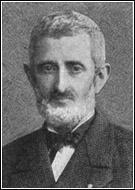Elijah Benamozegh

Elijah Benamozegh (born 1823 – died 6 February 1900),
Life
He was born in

At the age of twenty-five he entered a commercial career, spending all his leisure time in study; but his natural tendency toward science and an active religious life soon caused him to abandon the pursuit of wealth. He then began to publish scientific and apologetic works, in which he revealed a great attachment to the Jewish religion, exhibiting at the same time a broad and liberal mind. His solicitude for Jewish traditions caused him to support Kabbalah. Later, Benamozegh was appointed rabbi and professor of theology at the rabbinical school of his native town; and, his other occupations notwithstanding, he continued to write and defend Jewish traditions until his death, in Livorno.
Religious universalism
| Part of a series on |
| Jewish philosophy |
|---|
 |
Benamozegh's works are noted for his free and uninhibited use of various non-Jewish religious sources, especially the
In his theological works, Benamozegh suggested to explain the
Benamozegh offered a novel mystical interpretation of
Indeed, dualistic, panentheistic, and highly complex views of the Godhead are common in the Kabbalistic literature.[11][12][13] A number of known rabbis criticized Kabbalah for Gnostic-like dualistic views of God.
A particular interest was evolutionary theory and its universalist implications. Over time, Benamozegh came to view
Benamozegh's universalist views were recently promoted by Adin Steinsaltz, who made a somewhat similar attempt to unify all major world religions and philosophies.[15][16]
Cosmopolitanism and patriotism
Benamozegh considered himself, simultaneously, an Italian
At the same time, Benamozegh was a staunch Italian patriot. He even wrote a daring formulation, based on the Jewish
Works
- "Emat Mafgia'" (The Fear of the Opponent), a refutation of Leon of Modena's attacks upon the Cabala, in 2 vols., Leghorn, 1858
- "Ger Tzedek" (A Righteous Proselyte), critical notes on Targum Onkelos, ib., 1858
- "Ner le-David" (Lamp of David), commentary on the Psalms, published together with the text, ib., 1858
- "Em la-Mikra" (Matrix of Scripture), commentary on the Pentateuch containing critical, philological, archeological, and scientific notes on the dogmas, history, laws, and customs of the ancient peoples, published together with the text under the title "Torat Adonai," Leghorn and Paris, 1862–65
- "Ta'am Leshad," refutation of Samuel David Luzzatto's dialogue on the Cabala, Leghorn, 1863
- "Mebo Kelali," general introduction to the traditions of Judaism, published in "Ha-Lebanon," 1864, pp. 73 et seq.
- "Storia degli Esseni," Florence, 1865
- "Morale Juive et Morale Chrétienne. Examen Comparatif Suivi de Quelques Réflexions sur les Principes de l'Islamisme," Paris, 1867
- "Jewish and Christian Ethics with a Criticism on Mahomedism" (English translation of the above. E. Blochman, 1873)
- "Teologia Dogmatica ed Apologetica," Leghorn, 1877 (on metaphysics)
- "Le Crime de la Guerre Dénoncé à L'Humanité," Paris, 1881 (this work won for its author a medal and honorable mention from the Édouard Laboulaye, and Frédéric Passy)
- "Ya'aneh be-Esh" (He Will Answer Through Fire), discussion of cremation according to the Bible and the Talmud, Leghorn, 1886.
- "Israël et l'Humanité" (Israel and Humanity), discussion of universal religion and the roles of and relationships between Judaism, Christianity, and Islam, 1914 (posthumous, edited by Aimé Pallière).
References
- ^ S2CID 170858477.
- ^ S2CID 243702643.
- Yashar Books, 2006. page 241-242
- ^ "Institute for Jewish Ideas and Ideals: Rabbi Eliyahu Benamozegh: Israel and Humanity". Jewishideas.org. 2008-10-24. Retrieved 2013-12-07.
- ^ Azagury, Yaëlle (28 December 2017). "The forgotten Sephardi heritage: Rabbi Elijah Benamozegh". The Jerusalem Post. Retrieved 7 February 2023.
- ISBN 9780521517409.
- ^ ISBN 0-8091-3541-8, p. 43: Christianity... also associated the sephirot Tiferet and Malkhut materially and definitely in the person of Christ. Benamozegh contended that, with the dogma of the Incarnation, Christianity invalidated one of the basic tenets of Kabbalah - namely, the perpetual tension between the real and the ideal, symbolized precisely by Malkhut and Tiferet; p. 61-64:The very core of Feuerbach's criticism, the anthropomorphic nature of this idea of the divinity, does not bother Benamozegh at all.
- ISBN 0-8047-5371-7, p. 329: Jesus was a good Jew who did not dream of founding a rival church; p. 202: According to Christianity, the descend of God into the finite is accomplished in the bosom of mankind alone, or rather in a single man; but for the Kabbalah, the incarnation exists in and through the very fact of the entire creation, although man occupies the central focus.
- ^ The Unknown Sanctuary: A Pilgrimage from Rome to Israel, by Aime Palliere, Bloch Pub Co, 1986
- ^ Loughran, James; Klenicki, Leon. "The Thought and Life of Elijah Benamozegh". Jcrelations.net. Retrieved 2013-12-07.
- ^ Jewish Gnosticism, Merkabah Mysticism, and Talmudic Tradition, by Gershom Scholem
- ^ Abraham Cohen de Herrera, by Nissim Yosha, Routledge Encyclopedia of Philosophy
- ^ Between Enlightenment and Romanticism: Computational Kabbalah of Rabbi Pinchas Elijah Hurwitz, by Yoel Matveyev, History and Philosophy of Logic 32 (1)
- S2CID 54063674.
- Project MUSE 176866.
- Project MUSE 176866.
![]() This article incorporates text from a publication now in the public domain: Isidore Singer and Isaac Broydé (1901–1906). "Benamozegh, Elijah". In Singer, Isidore; et al. (eds.). The Jewish Encyclopedia. New York: Funk & Wagnalls.
This article incorporates text from a publication now in the public domain: Isidore Singer and Isaac Broydé (1901–1906). "Benamozegh, Elijah". In Singer, Isidore; et al. (eds.). The Jewish Encyclopedia. New York: Funk & Wagnalls.
External links
- Jewish and Christian ethics with a criticism on Mahomedism English translation of Morale Juive et Morale Chrétienne
- The Thought and Life of Elijah Benamozegh
